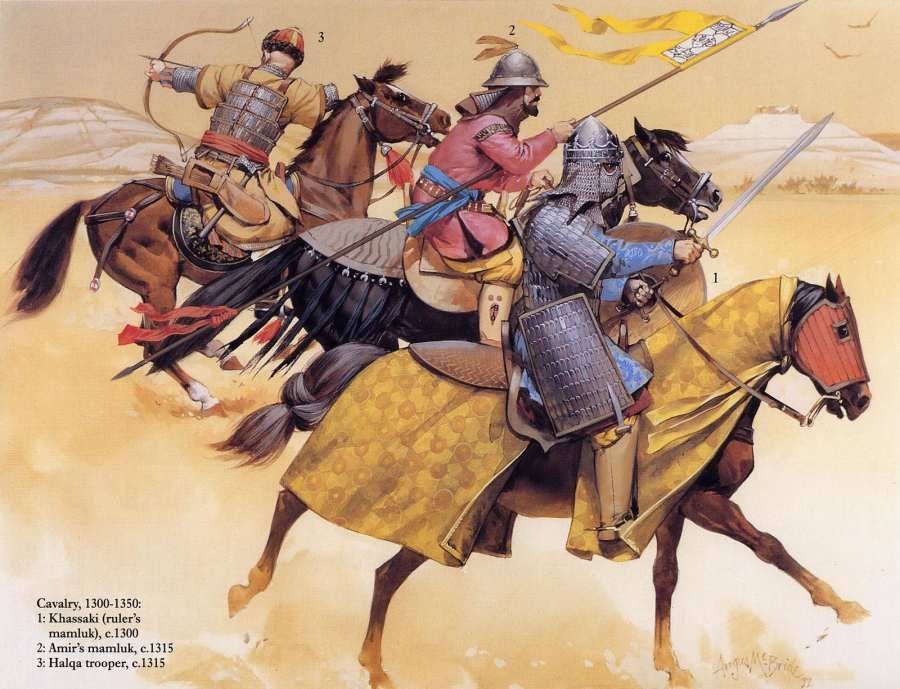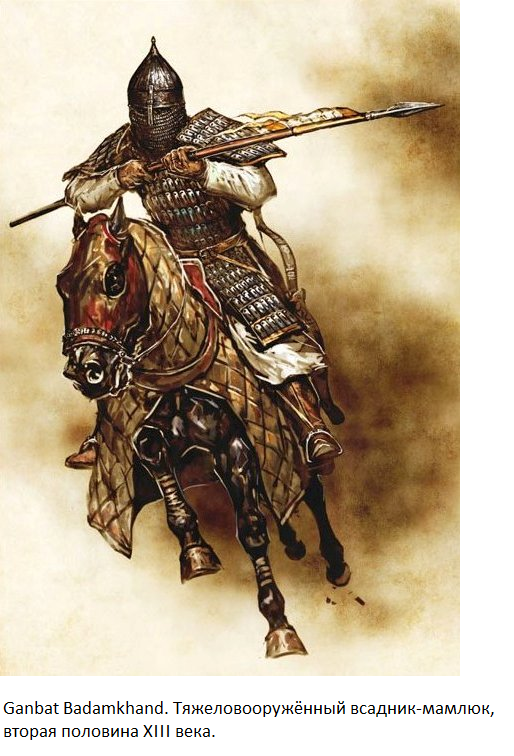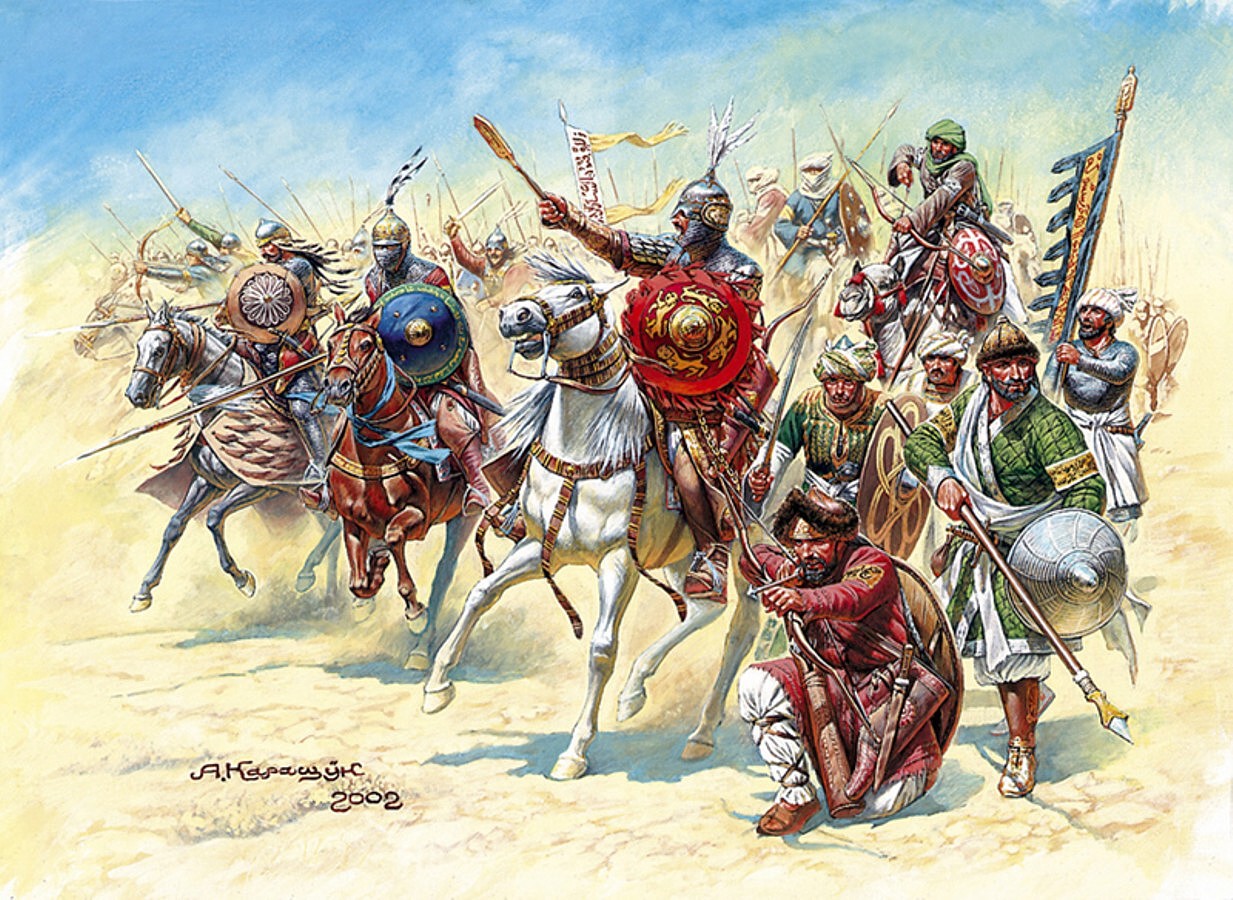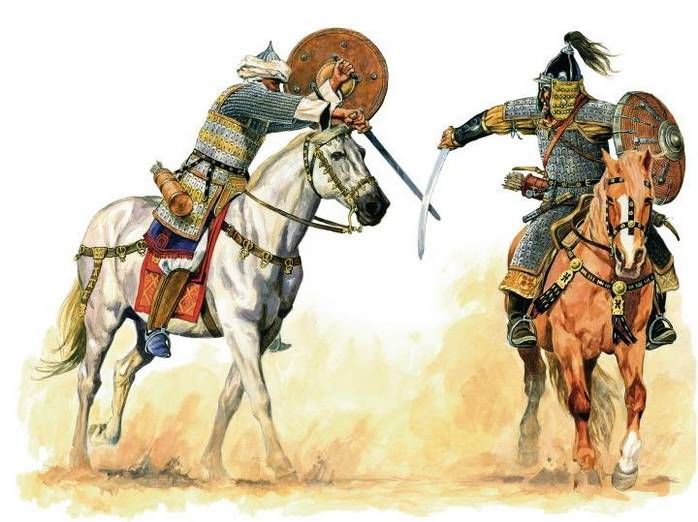Mamluk Archery
Mamluk Archery
The Mamluks were originally slaves. The word comes from the Arabic for one who is owned; a captive slave (Arabic: مملوك, romanized: mamlūk (singular), مماليك, mamālīk (plural)), translated as “one who is owned”. These particular slaves, however, were warrior slaves and were to be used in military affairs. In fact, a large part of most armies in the Islamic world from the 9th to the 19th century was composed of slave soldiers. This article discusses the Mamluks and Mamluk archery in a historical context.

Mamluk Origins & History
As mentioned the word Mamluk refers to slave soldiers. Mamluks were specifically, non-Arab slaves, or freed slaves which were used for military or administrative roles in the medieval Arab-Muslim realms. The Middle East has a long history of utilizing slave soldiers. Many foreigners were recruited into Arab armies by the Abbasids in the ninth century, as well as by the Fatimid and Ayyubid dynasties that followed. Turks and Eastern Europeans (mostly Armenians and Georgians) made up the majority of those recruited into the ranks of the Mamluks.
Mamluks or enslaved mercenaries formed the elite core of most armies in the Muslim world from the 9th to 19th Centuries. They were taken as children and trained in all affairs related to the military at the time. Unlike traditional or household slaves, the Mamluks had certain privileges beyond these ordinary slaves such as being able to be armed.

The Royal Mamluks
A group of Mamluks who had been captured, raised, and trained by the Sultan himself formed the core of the military and are referred to today by scholars as Royal Mamluks.
These Royal Mamluks received the very best in terms of training, weapons, gear as well as wages. Yes, even though they were captured against their will, they were compensated financially for their services.
As well as serving the Sultan, Mamluk forces were also held by lesser administrators or amirs. The number of Mamluks a Sultan could muster depended on his financial and military situation. Some estimates as to how many a ruler had at one-time range anywhere from 2 to 16,000 men.
The personal bodyguards of the Sultan (The khassakiyya) were selected from the Royal Mamluks. They would guard the Sultan in his personal quarters and were some of the few individuals to have access to him there. Due to their close proximity to the ruler, many Mamluks in this role had opportunities to rise to key positions within the administration.
Being brought up and trained in a barracks, these young men spent much if not all of their time with each other. They had no outside social ties or political leanings and thus were expected to remain loyal to their duties and their owner.
Their pastimes included Mamluk archery and demonstrations of mounted combat which were held up to twice a week.
Mamluk Sultanate
The Mamluks rose to prominence in Egypt and Syria after the famed Saladin established the Ayyubid Dynasty in 1171. Most of the Mamluks under Ayyubid ownership at this time were taken from the Turkic-Kipchaks of the Central Steppe. The Kipchaks already had mounted combat and archery in their blood, so the mounted archery culture of the steppe became Mamluk archery in the medieval Near East.
The Mamluks served their masters well and were given high offices in the military. Their influence continued to rise, which worried their owners, particularly the Ayyubids.
Eventually, a Mamluk would become Sultan, and the Mamluk Sultanate was established and ruled from 1250 to 1517. It possessed one of the first true large professional armies of the Medieval period.

Equestrian Prowess & Furūsiyya
The main component and emphasis of the Mamluks in terms of their military skill was the cavalry. The term Furūsiyya in Arabic refers to equestrianism, and in our context, more specifically to military equestrianism.
Furūsiyya is an art and science concerned with the martial arts and equestrianism of the Golden Age of Islam and the Mamluk period (roughly 10th to 15th centuries), reaching its peak in Mamluk Egypt during the 14th century.
The three main components of Furūsiyya. plus a fourth added later are as follows:
- Horsemanship. This includes the proper riding of the animal as well as all veterinary aspects and general horse care.
- Archery. This includes all aspects of the activity, from building and maintaining the equipment to proper forms and techniques.
- The lance. The other main weapon and mode of military conduct of the Mamluks was the lance. Particularly charging with the lance.
- The sword. Ibn Qayyim al-Jawziyya adds swordsmanship as a fourth discipline in his treatise Al-Furūsiyya (1350)
Furūsiyya may be regarded as and has several similarities with the code of chivalry of the Western medieval knight. These two schools would have surely come into contact with and influenced each other during the crusades.

Munyatu’l-Guzat, or Wish of the Warriors of the Faith
Several Furūsiyya texts were written under Mamluk’s rule. Written in Mamluk-Kipchak, the Munyatu’l-Guzat, or Wish of the Warriors of the Faith, is a fourteenth-century martial arts manual. It describes all aspects of the chivalric arts practiced by the Mamluks. Of particular interest to our niche and study is the fifth chapter, the section on Mamluk archery.
The author describes the high expectations and rigorous training Mamluks were expected to undertake. The work is full of excellent common-sense tips and could very easily be used as a reference for modern archers in modern times. The following excerpt gives a feeling that indeed the author must have been very well acquainted with archery and was perhaps a skilled master himself.
“The worst thing is to try to shoot as well as your previous shot. (If you do) then you will lose (your accurate shooting). So you must not desire to shoot as well as (your) previous shot, but rather you should seek to better your shooting.”
The following sections or chapters contained within the work further elaborate on Mamluk archery in medieval times.
- On the quality of the bow (with which one) aims at high burcas and shoots at fortresses and at something that overlooks
- The arrow
- Attacking fortresses
- On shooting in war from the top of a fortress at (the people who are) at the base of the fortress
- Drawing the bow
- On shooting short arrows with a guide
- Shooting arrows from on top of a galloping horse. It has various graces
Mamluk Archery in Action
The Mamluks were relatively successful militarily during their prominence. Notable among their greatest achievements was the defeat of King Louis IX of France and some hard-fought yet decisive victories over the Mongols. Mamluk archery as well as their exquisite horsemanship played an important role. The following sections cover some of these victories against tough enemies.
The 7th Crusade of King Louis IX of France
It was in the 1240s that pressure from the Mongols on the eastern boundaries of the Kurdish Ayyubid dynasty began to have an effect on the Middle East. An eastern Persian people known as the Khwarezmians made their way to Jerusalem, escaping the Mongol threat. While there, and with the apparent support of the Ayyubids, they managed to desecrate the tombs of some Latin kings. The Crusaders did not like this one bit, especially not King Louis IX of France.
Being a religious man, in fact, the only king of France to be canonized, Louis surely desired vengeance for the defiling of Christian holy sites. He, therefore, organized what is known as the 7th Crusade. Although his venture did not garner the official support of the papacy nor of any other powerful Christian monarch, Louis set sail for the Middle East.

Louis’s plan for this crusade was not to attack the Holy Land (modern-day Israel, Jordan, Lebanon, Syria) directly. The plan was to take hold of the rich lands of Egypt, from which further excursions could be launched.
Louis and his followers (an army of about 20,000) landed in Egypt on 4 or 5 June 1249 and initiated their campaign with the swift capture of the port of Damietta. The Muslim armies withdrew up the Nile to a safe position.
This brazen attack seems to have caught the Ayyubids somewhat by surprise. Furthermore, there was already plenty of uncertainty within their empire as the current sultan, Al-Malik as-Salih Najm al-Din Ayyub, was ill and dying.
The Mamluks Counter
When as-Salih Ayyub died, power was transferred to his son al-Muazzam Turanshah. With the Mamluk’s support, the sultan’s favorite wife, Shajar al-Durr soon took control of the empire and launched a counterattack against the Franks.
Despite the chaos and uncertainty in the Empire’s capital of Cairo, Louis, and the Templars were roundly defeated by the Mamluk Bahirya commander Baibars at al-Mansourah (al-Mansur).
Louis delayed his retreat when the tide of battle was clearly not in his favor and was captured by the Mamluks in March of 1250. The king agreed to pay a handsome ransom (applause) of 400,000 Livres for his freedom, of which 150,000 livres were never paid.
After he was released, Louis spent some four years in the Kingdom of Jerusalem, using his wealth and connections to help the Crusaders with supplies and strengthen their defenses.
Victory Over the Mongols at Ayn Jalut in 1260
In 1251 one of the grandchildren of Ghenghis Khan, Möngke took the throne. He seems to have been an ambitious man, as he was quick to pick up where his ancestor had left off in terms of his goals for a global empire. While the new Khan would look after domestic affairs, as well as expansion into and wars with the Chinese, his brother Hulagu Khan another grandchild of Ghenghis was selected to deal with the empire’s expansion southwest, towards the Middle East.
After spending a good five years assembling the resources and men, in 1256 Hulagu was ready to make his moves toward the new front. The ever-mysterious Assassins of Persia were quick to fall. The Abbasid Caliphate of Baghdad as well as the Ayyubids in Damascus were destroyed.
The Mongols seemed to be on a roll again, which traditionally was not welcome news for other powers in the region. Hulagu dispatched envoys to Qutuz, the Mamluk sultan in Cairo, demanding the surrender of Egypt. Qutuz, being a man of war himself, did not take kindly to such threats and had the poor messengers killed, their heads being put on display on the Bab Zuweila gate of Cairo

The Battle
The battle at Ayn Jalut marked the height of the greatest extent of the Mongol conquests. Although this was not the first time a Mongol army was defeated, it was a first for a Mongol advance to be so decisively checked.
The Mongol army however was not in full force at the time of the battle. Hulagu withdrew from the region with the bulk of his army. Roughly one tumen (10,000 men) was left west of the Euphrates with his commander-general Kitbuqa Noyan.
It was believed Hulagu’s withdrawal was due to the death of his brother, the Great Khan Möngke during an expedition to China. It had been customary for senior officials and family members to rally after such deaths in order to decide a successor and set other political affairs in order.
Some more recent documentation however reveals Hulagu could not sustain such a large force in the region for long as the fodder for the horse had been used up and typical Mongol custom entailed a migration to cooler lands for the summer months.
Qutuz Makes His Move
In any event, when sultan Qutuz heard of this delightful news, he assembled a force in Egypt and made his way toward Palestine. Utuz was then allied with a fellow Mamluk, Baibars. The two leaders thought it wise to combine forces to defeat the great Mongol threat.
The Mamluk armies did have the advantage of knowing the terrain, and Qutuz, being the deceptive tactician that he was, hid the bulk of his forces. The plan was to bait the Mongols into a trap with a smaller contingent under Baibars. The Mamluks utilized all the common steppe warfare tactics such as hit-and-run, feigned retreats, and constant arrow fire. All this was done to provoke to Mongols into their trap while preserving the bulk of their forces.
Eventually, the Mongol commander did in fact make the mistake of pursuing the apparently fleeing Mamluks. The Mongols reached the highlands where Qutuz and the Mamluk forces lay hidden. The trap was sprung and the Mamluks began to fire arrows and attack with their cavalry. The Mongols then found themselves surrounded on all sides.
Mongols Defeated
The Mongols, fighting ever fiercely for their lives, attempted desperately to break the Mamluk lines. There was a slight breakdown of a portion of the Mamluk lines, yet it was all in vain. Some of the Mongol forces managed to escape with their lives. The Majority of Mongol forces, however, including their commander Kitbuqa perished.
Remembering that a large majority of Mamluks were of Kipchak origin, these were essentially two steppe armies fighting it out. The contemporary Arab historian Abu Shama noted after the Mamluk victory over the Mongols at Ayn Jalut in 1260 that, “the people of the steppe had been destroyed by the people of the steppe”.
First Battle of Homs (1260)
After the Mongol defeat at Ayn Jalut, Hulagu was surely not a happy man. He had some Ayyuubid princes and the Sultan executed. Because of the civil war among the Mongols at this time, only 6000 troops were sent back into the Levant. They were however soundly defeated at Homs.
Second Battle of Homs
The war-like peoples of the steppe, including the Mongols, were definitely known for being relentless in their military affairs. The Mongols wanted Syria and were determined to get it. The Second Battle of Homs was fought in western Syria on 29 October 1281.
The Mamluk center, being led by Sultan Qalawun managed to swiftly crush the Mongol center positions. The Mongol leader Möngke Temur had been injured and decided to flee. The rest of his battered and disorganized army followed. Qalawun chose not to pursue the retreating enemy.
Mamluk Archery, Archery Retailer from Turkey

If you search Mamluk archery on Google, you will surely see a result for mamlukarchery.org. The online retailer was founded in 2017 and specializes in all things traditional Turkish archery. From archery equipment to traditional clothing and armor, we would highly encourage you to check out their website via the link below.
Thank you, God bless and take care.